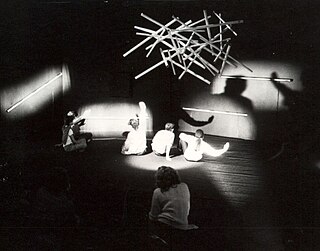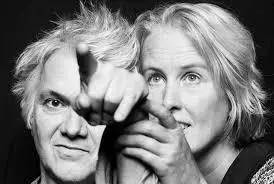
Digital art is an artistic work or practice that uses digital technology as part of the creative or presentation process. Since the 1960s, various names have been used to describe the process, including computer art and multimedia art. Digital art is itself placed under the larger umbrella term new media art.

Interactive art is a form of art that involves the spectator in a way that allows the art to achieve its purpose. Some interactive art installations achieve this by letting the observer or visitor "walk" in, on, and around them; some others ask the artist or the spectators to become part of the artwork.
Computer art is any art in which computers play a role in production or display of the artwork. Such art can be an image, sound, animation, video, CD-ROM, DVD-ROM, video game, website, algorithm, performance or gallery installation. Many traditional disciplines are now integrating digital technologies and, as a result, the lines between traditional works of art and new media works created using computers has been blurred. For instance, an artist may combine traditional painting with algorithm art and other digital techniques. As a result, defining computer art by its end product can thus be difficult. Computer art is bound to change over time since changes in technology and software directly affect what is possible.

Manfred Mohr is a German artist considered to be a pioneer in the field of digital art. He has lived and worked in New York since 1981.

Jodi, is a collective of two internet artists, Joan Heemskerk and Dirk Paesmans, created in 1994. They were some of the first artists to create Web art and later started to create software art and artistic computer game modification. Their most well-known art piece is their website, which is a landscape of intricate designs made in basic HTML. JODI is represented by Upstream Gallery, Amsterdam.

The Prix Ars Electronica is one of the best known and longest running yearly prizes in the field of electronic and interactive art, computer animation, digital culture and music. It has been awarded since 1987 by Ars Electronica.
Digital painting is a relatively new but an already established art form. It’s a medium that typically combines a computer, a graphics tablet, and software of choice. The artist uses painting and drawing techniques with the stylus that comes with the graphics tablet to create 2D paintings within a digital art software. There are multiple techniques and tools that are utilized by digital artists, the first being digital brushes. These come standard with all digital art programs but users can create their own, altering their shape, texture, size, and transfer. Many of these brushes are created to represent traditional styles like oils, acrylics, pastels, charcoal, and airbrushing, but not all. Other effective tools include layers, lasso tools, shapes, and masks. Digital painting has evolved to not just mimic traditional art styles but fully become its own technique.

Herbert W. Franke is an Austrian scientist and writer. Die Zeit calls him "the most prominent German writing Science Fiction author". He is also one of the important early computer artists, creating computer graphics and early digital art since the late 1950s. Franke is also active in the fields of future research as well as speleology. He uses his pen name Sergius Both as this Avatar name in Active Worlds and Opensimulator grids. The Sergius Both Award is given for creative scripting in Immersionskunst by Stiftung Kunstinformatik, first time issued at Amerika Art 2022.

Golan Levin is an American new media artist, composer, performer and engineer interested in developing artifacts and events which explore supple new modes of reactive expression.

Mark Tribe is an American artist. He is the founder of Rhizome, a not-for-profit arts organization based in New York City.

Sir Christopher Mark Le Brun PPRA is a British artist, known primarily as a painter. He was President of the Royal Academy of Arts from the time of his election in 2011 to December 2019. Le Brun was knighted in the 2021 New Year Honours for services to the arts.
John F. Simon Jr., is a new media artist who works with LCD screens and computer programming. He currently lives and works in New York City.
Margot Lovejoy was a digital artist and historian of art and technology. She was Professor Emerita of Visual Arts at the State University of New York at Purchase. She was the author of Digital Currents: Art in the Electronic Age. Lovejoy was recipient of a 1987 Guggenheim Fellowship and a 1994 Arts International Grant in India.
Roman Verostko is an American artist and educator who creates code-generated imagery, known as algorithmic art. Verostko developed his own software for generating original art based on form ideas he had developed as an artist in the 1960s. His software controls the drawing arm of a machine known as a pen plotter that was designed primarily for engineering and architectural drawing. In coding his software Verostko conceives of the machine's drawing arm as an extension or prosthesis for his own drawing arm. The plotter normally draws with ink pens but Verostko adapted oriental brushes to fit the drawing arm and wrote interactive routines for achieving brush strokes with his plotters. In 1995, he co-founded the Algorists with Jean-Pierre Hébert.

New media art includes artworks designed and produced by means of electronic media technologies, comprising virtual art, computer graphics, computer animation, digital art, interactive art, sound art, Internet art, video games, robotics, 3D printing, and cyborg art. The term defines itself by the thereby created artwork, which differentiates itself from that deriving from conventional visual arts. New Media art has origins in the worlds of science, art, and performance. Some common themes found in new media art include databases, political and social activism, Afrofuturism, feminism, and identity, a ubiquitous theme found throughout is the incorporation of new technology into the work. The emphasis on medium is a defining feature of much contemporary art and many art schools and major universities now offer majors in "New Genres" or "New Media" and a growing number of graduate programs have emerged internationally. New media art may involve degrees of interaction between artwork and observer or between the artist and the public, as is the case in performance art. Yet, as several theorists and curators have noted, such forms of interaction, social exchange, participation, and transformation do not distinguish new media art but rather serve as a common ground that has parallels in other strands of contemporary art practice. Such insights emphasize the forms of cultural practice that arise concurrently with emerging technological platforms, and question the focus on technological media per se. New Media art involves complex curation and preservation practices that make collecting, installing, and exhibiting the works harder than most other mediums. Many cultural centers and museums have been established to cater to the advanced needs of new media art.
John David Lloyd is a British graphic designer who in 1975 co-founded the international design consultancy, Lloyd Northover. He has worked in all fields of graphic design but has specialised in corporate identity.
Michael Reisch is a German artist and photographer. Reisch exhibited nationally and internationally. His works are included in collections worldwide, including the Los Angeles County Museum of Art, USA and National Gallery of Scotland Edinburgh, Scotland. His works combine aspects of documentary photography, painting and sculpture. He lives in Düsseldorf.

Sissel Tolaas is a Norwegian artist and researcher known for her work with smells.
Jane Veeder is an American digital artist, filmmaker and educator. She is a professor at San Francisco State University in the Department of Design and Industry, at which she held the position of chair between 2012 and 2015. Veeder is best known for her pioneering work in early computer graphics, however she has also worked extensively with traditional art forms such as painting, ceramics, theatre, and photography.
Victor Acevedo is an American artist best known for his digital work involving printmaking and photography. He was introduced to computer graphics while attending Gene Youngblood's survey class (based on his book Expanded Cinema) at Art Center College of Design in Pasadena, California.










